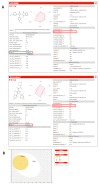Chemical Synthesis, Pharmacokinetic Properties and Biological Effects of JM-00266, a Putative Non-Brain Penetrant Cannabinoid Receptor 1 Inverse Agonist
- PMID: 35328343
- PMCID: PMC8949893
- DOI: 10.3390/ijms23062923
Chemical Synthesis, Pharmacokinetic Properties and Biological Effects of JM-00266, a Putative Non-Brain Penetrant Cannabinoid Receptor 1 Inverse Agonist
Abstract
Targeting cannabinoid 1 receptors (CB1R) with peripherally restricted antagonists (or inverse agonists) shows promise to improve metabolic disorders associated with obesity. In this context, we designed and synthetized JM-00266, a new CB1R blocker with limited blood-brain barrier (BBB) permeability. Pharmacokinetics were tested with SwissADME and in vivo in rodents after oral and intraperitoneal administration of JM-00266 in comparison with Rimonabant. In silico predictions indicated JM-00266 is a non-brain penetrant compound and this was confirmed by brain/plasma ratios and brain uptake index values. JM-00266 had no impact on food intake, anxiety-related behavior and body temperature suggesting an absence of central activity. cAMP assays performed in CB1R-transfected HEK293T/17 cells showed that the drug exhibited inverse agonist activity on CB1R. In addition, JM-00266 counteracted anandamide-induced gastroparesis indicating substantial peripheral activity. Acute administration of JM-00266 also improved glucose tolerance and insulin sensitivity in wild-type mice, but not in CB1R-/- mice. Furthermore, the accumulation of JM-00266 in adipose tissue was associated with an increase in lipolysis. In conclusion, JM-00266 or derivatives can be predicted as a new candidate for modulating peripheral endocannabinoid activity and improving obesity-related metabolic disorders.
Keywords: CB1R antagonist; Rimonabant; SWISSADME prediction; drug discovery; endocannabinoid system; obesity; pharmacokinetics.
Conflict of interest statement
The authors declare no conflict of interest.
Figures






Similar articles
-
New peripherally-restricted CB1 receptor antagonists, PMG-505-010 and -013 ameliorate obesity-associated NAFLD and fibrosis.Biomed Pharmacother. 2024 Nov;180:117501. doi: 10.1016/j.biopha.2024.117501. Epub 2024 Oct 3. Biomed Pharmacother. 2024. PMID: 39366030
-
CB1 receptor blockade counters age-induced insulin resistance and metabolic dysfunction.Aging Cell. 2016 Apr;15(2):325-35. doi: 10.1111/acel.12438. Epub 2016 Jan 13. Aging Cell. 2016. PMID: 26757949 Free PMC article.
-
A novel peripheral cannabinoid 1 receptor antagonist, AJ5012, improves metabolic outcomes and suppresses adipose tissue inflammation in obese mice.FASEB J. 2019 Mar;33(3):4314-4326. doi: 10.1096/fj.201801152RR. Epub 2018 Dec 19. FASEB J. 2019. PMID: 30566396
-
MECHANISMS IN ENDOCRINOLOGY: Endocannabinoids and metabolism: past, present and future.Eur J Endocrinol. 2017 Jun;176(6):R309-R324. doi: 10.1530/EJE-16-1044. Epub 2017 Feb 28. Eur J Endocrinol. 2017. PMID: 28246151 Review.
-
Overcoming the Psychiatric Side Effects of the Cannabinoid CB1 Receptor Antagonists: Current Approaches for Therapeutics Development.Curr Top Med Chem. 2019;19(16):1418-1435. doi: 10.2174/1568026619666190708164841. Curr Top Med Chem. 2019. PMID: 31284863 Free PMC article. Review.
Cited by
-
Resting State Brain Networks under Inverse Agonist versus Complete Knockout of the Cannabinoid Receptor 1.ACS Chem Neurosci. 2024 Apr 17;15(8):1669-1683. doi: 10.1021/acschemneuro.3c00804. Epub 2024 Apr 4. ACS Chem Neurosci. 2024. PMID: 38575140 Free PMC article.
References
MeSH terms
Substances
Grants and funding
LinkOut - more resources
Full Text Sources
Medical
Research Materials

